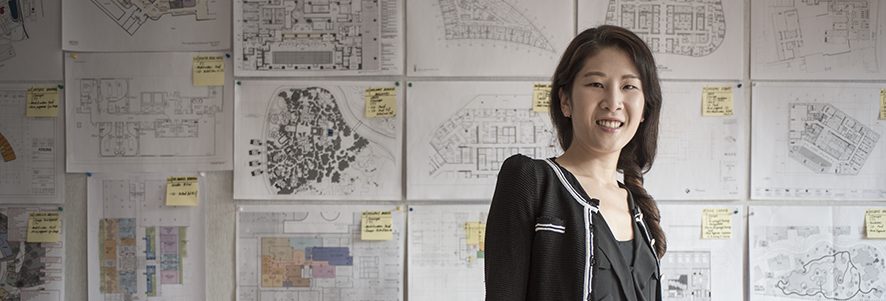Originally published on: TravelDailyNews.Asia
Josephine Leung, Group Director of Design and Development at GOCO Hospitality, talks about how unique guest experience can be created through design.
TravelDailyNews: How can design be used to create exceptional guest experiences?
Josephine Leung: When designing a hospitality space, our approach starts with identifying the uniqueness of each project location: its history, culture, environment and the target segment. We analyse what is special and start the design by enhancing what is there locally and try our best to preserve the natural resources, be ‘light’ on the soil and create the design from the ground up.
Everywhere has a story and a community, and the spaces we design should reflect that. Guests want the hotel to provide them with an immersive experience in the location.
“Everywhere has a story and a community, and the spaces we design should reflect that.”
Josephine Leung
Crafting a unique guest experience all starts with creating the physical space and how that integrates with the land and the existing environment. The design needs to firstly consider the overall planning of how a guest moves and flows through the spaces within the property as well as the scale and intimacy of those spaces. There is also, of course, the look and feel and ambience that we wish to create. This is what most people think of designers doing, but we also think very carefully about issues such as the connection of indoor spaces with the outdoor ones. Finally, we go all the way down to the finest details of materials, texture, sound and lighting.
All these are an integral part to support the emotions and impressions we intend to convey to our guests, contributing to a unique experience for each and every project.
TDN: Can design lead to better profits for hotel owners?
J.L.: A good design can have a significant impact on the profitability of a hotel. It is very important that hotel designers tailor their design to suit the hotel’s overall business plan, its market positioning and the anticipated target guest segment and their needs.
A successful hospitality design is one that is not only aesthetically pleasing, but, at the same time, is aligned to the business projections, provides maximum effectiveness in the future operations, economises on staffing costs as well as long-run operational costs.
One of the key elements in the design of a hospitality space is the planning of the guest spaces in relation to employees and support areas.
A good designer understands the operational requirements, how the employee flows within the property and what type of support elements are required.
TDN: What are the most important considerations right now in hospitality design?
J.L.: As with almost every industry around the world, technological developments are playing an ever more important role in hotel designs. New materials, equipment and construction techniques are continuously being developed that change the way we design. Furthermore, as environmental crises become more evident, the demand for a sustainable or green design is now a necessity, and designers need to employ the latest technological innovations combined with a sensitive design that respects our environment and natural resources.
Specifically in the design of spa and wellness facilities, we focus on designing spaces that create a healthy and positive environment for guests. We need to consider issues such as indoor air quality, the use of natural and local materials and eliminating materials that give off toxic fumes. We want to allow plentiful natural light to save on on-going energy costs and allow guests to connect with nature. We also wish to integrate energy- and water-saving appliances and fittings.
A further trend is rethinking how traditional spaces are used. I like to look at a space and imagine how it can be used for other purposes. Can a restaurant also be used as a cooking school during quieter periods? Can we develop flexible meeting, social and co-working spaces that enhance guest interaction? A rooftop space can be a yoga platform for dramatic sun salutations in the mornings and then transform into a bar for the evening sunset. In this way, our utilisation of these spaces increases, making them more efficient real estate investments.
TDN: What are the biggest mistakes that designers and hotel owners make when creating spa and wellness spaces?
J.L.: The most common mistake is certainly a focus on aesthetics over functionality and operational requirements. Hospitality spaces should not be over-designed or under-designed. The design needs to be commensurate and aligned to how the space will be used as well as the target guest segment.
Another common mistake is failing to invest in and source the right project consultants and experts at the beginning of the project. It is important for an owner or developer to engage an experienced team right from the start. Although the initial cost will be greater, having the right partner will save you more throughout the design and development process, and ultimately the project will be much more profitable and successful.
TDN: Where do you see the design of wellness spaces heading in the next 5-10 years?
J.L.: The wellness sector is still at a very early stage of its development. The demand of wellness-related developments, from spas and wellness hotels to even wellness communities is growing tremendously. There will be a shortage in the market for professional expertise in creating and managing these facilities.
At the same time, there will be many opportunities for creativity in conceptualising wellness spaces and resorts. Over the next few years, we will be seeing a lot of interesting and unique developments being created, so it is a very exciting time right now.
While there will be a lot of new projects and products coming online, it will be difficult to avoid mistakes being made, given the lack of research, data and experience in the overall market.

